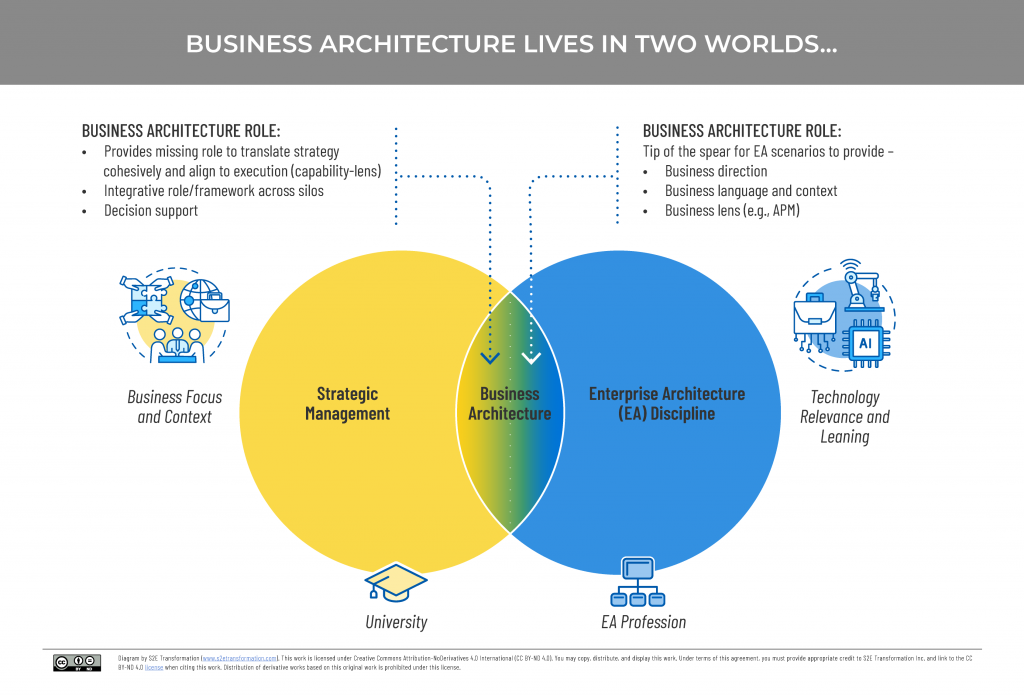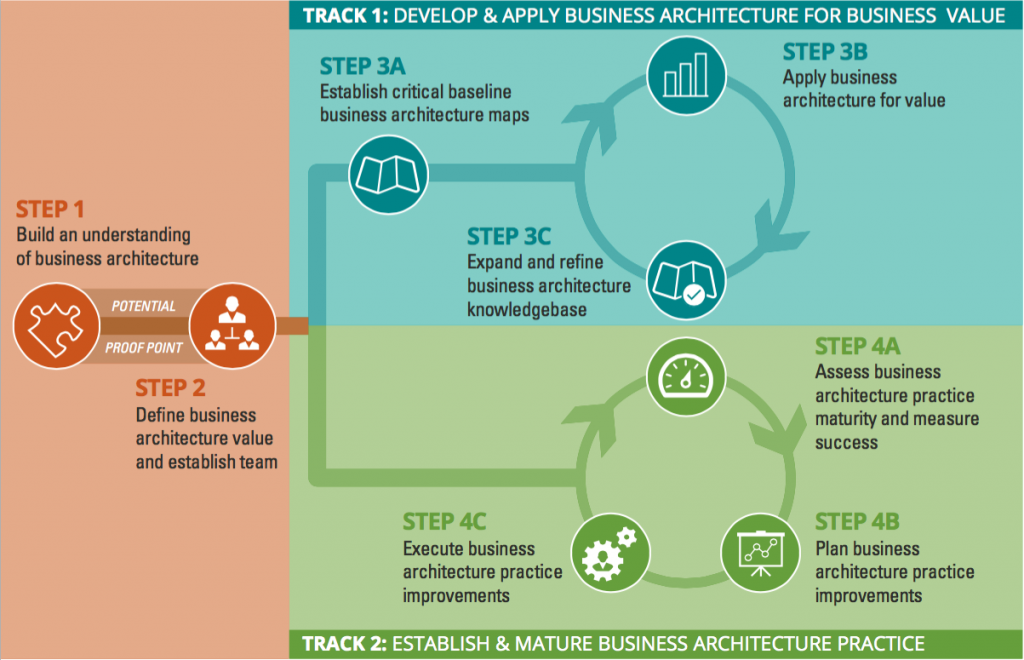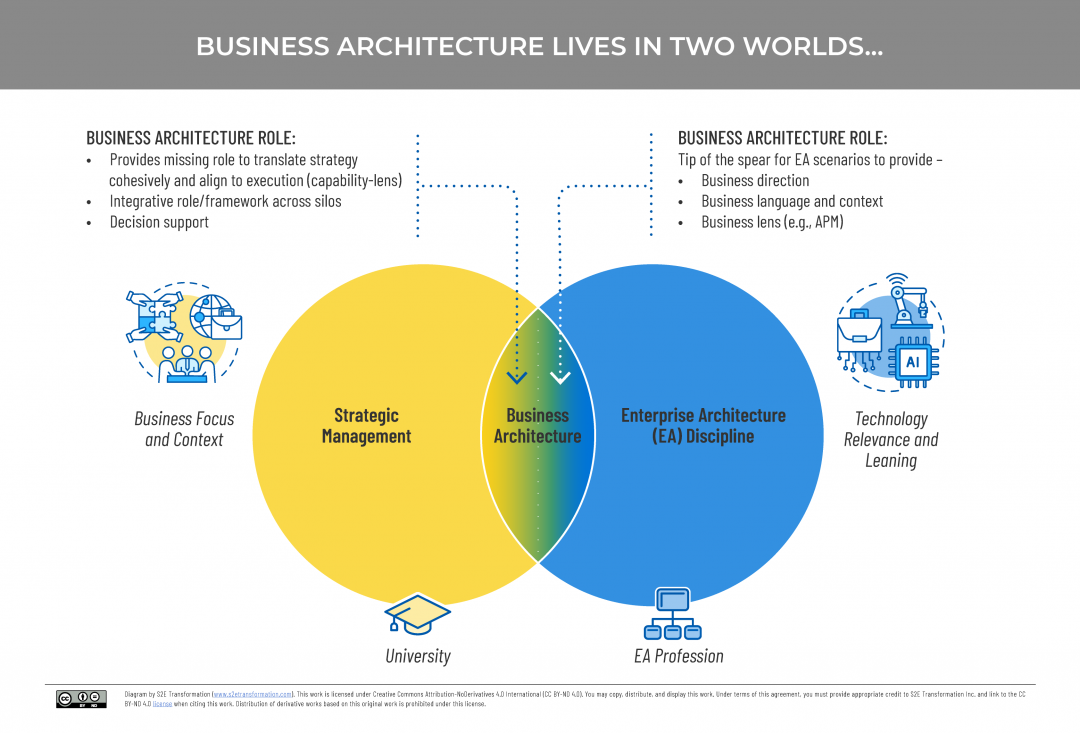By Whynde Kuehn, S2E and Biz Arch Mastery Founder | Strategy to Reality Author | Passionate Advocate for Strategy Execution + Business Architecture

As a global discipline, business architecture is here and here to stay. It has been gaining traction and recognition, especially as an enabler of strategy execution and transformation. The discipline has also continued to formalize and advance within organizations, professional associations, and even academia. For many organizations – regardless of industry or sector – the question is no longer if they should create an internal business architecture practice, but rather how best to do so for the greatest chances of success. In this article, we will explore globally proven best practices and approaches for building a strategic business architecture practice within an organization.
Strategic positioning is key to long-term business architecture success.
The contemporary practice of business architecture has evolved to exist within two worlds, as shown in the Venn diagram below. On one hand, business architecture is a part of the enterprise architecture umbrella where it serves as the tip of the spear to provide business direction, language, context, and perspective for more technology-related scenarios such as application portfolio management or cloud strategy and migration decision-making. (See right side of diagram.) On the other hand, business architecture provides a missing role and framework that has arguably been missing within strategic management to translate strategies cohesively and align them with execution, connect silos, and inform more holistic decision-making. (See left side of diagram.) There is a continuum of usage scenarios for business architecture that need to be covered (as shown in the overlap space of the diagram) and both sides are important.

Successful teams have increasingly been positioning business architecture as the bridge between strategy and execution within their organization. This means that more teams are reporting to business leaders and are involved upfront to inform and translate strategy and shape and align initiatives. It also means that business architects are honing their strategic business competencies and building partnerships with many teams across the entire strategy execution life cycle.
This strategic positioning most importantly helps to bridge the gap between strategy and execution that is often missing in organizations, but it also puts business architecture teams closer to where business direction and change is happening within an organization. This helps business architects – and other members of the enterprise architecture team – get to the right tables, early in the life cycle, when architecture can contribute the most value.

Success is when business architecture delivers value and becomes embedded.
How can we define success for an organization that leverages business architecture? There are maturity models that measure progress, but most importantly, business architecture success is measured through results.
Business architecture success is reflected in how people within an organization act. This occurs when business architecture:
- Is embedded into the fabric of an organization – This includes fully integrating business architecture into strategy execution and with other teams and frameworks. It also means that anyone in an organization can and does leverage business architecture for common understanding and decision-making.
- Is leveraged as a strategic discipline – This also requires business architects to be highly skilled, strategic resources and trusted advisors.
- Delivers on its intended value proposition – This occurs when business architecture achieves the business outcomes for which it was intended and brings agility and advantage to an organization.
Business architecture success is also reflected in how people within an organization think. It facilitates the following types of mindset shifts:
- Relentless customer value delivery: shifting from an internal inside-out perspective to a customer-focused outside-in perspective
- Cross-organization collaboration: shifting from silo orientation to enterprise optimization and cross-business unit partnership
- Big picture thinking: shifting from narrowly focused investments and problem-solving to systemic thinking and approaches
- End-to-end organizational agility: shifting from a bias towards action and a focus on execution agility to focusing on doing the right things and agility from strategy through execution
- Intentional design: shifting from solutions that meet the needs of today to an effectively architected and designed environment that will meet the needs of tomorrow
- Business first thinking: shifting from leading with technology and solutions to leading with business goals and outcomes first
A proven approach for succeeding with business architecture has emerged.
There is a formula for establishing and socializing business architecture within an organization that teams around the world have been continually adopting – and it is working.[1] It starts with identifying a business sponsor, helping them to articulate the intended business value and outcomes for business architecture that are tailored to the organization, successfully delivering repeatable services to achieve those outcomes, and then telling the story to others to gain buy-in. Even if a business sponsor is not available in the beginning, the continual delivery and socialization of value is what builds momentum for business architecture until that person can come alongside the team. As business architecture gains recognition among executives and academics, this bottom-up approach may evolve – or at least get easier – but at this juncture for the discipline, it is proving to be a formula for success.
Successful business architecture teams also follow the overarching mantra of lead with value and build as you go. As shown in the diagram below, establishing a business architecture practice starts with understanding business architecture (Step 1) and defining its value proposition (Step 2). Then, a business architecture baseline is built to represent the organization at a high level, consisting of capabilities, value streams, and a cross-mapping between the two (Step 3A). From that point forward though, the emphasis shifts to the usage of business architecture for value (Step 3B) – and the knowledgebase (Step 3C) and supporting practice infrastructure (Track 2) is refined and expanded just enough just in time in support of the value to be delivered.

Consider the top success factors.
The top success factors for establishing a business architecture practice can be summarized as follows:
- Define a clear value proposition for business architecture in the organization and deliver it via repeatable services; build the knowledgebase and practice just enough just in time
- Build strong partnerships with other roles and teams
- Obtain early executive business sponsorship for business architecture, but if not feasible earn it by continually delivering value
- Practice business architecture as a strategic enterprise discipline
- Create a cohesive business architecture practice across the organization with one shared business architecture knowledgebase and methodology shared by practitioners
- Make business architecture for everybody
If your organization has a business architecture practice, here are a few questions you can ask to assess your progress and identify opportunities for advancement:
- Clear Value Proposition – Does business architecture have a simple, clear, and relevant value proposition for the organization that is consistently understood among the team and the key stakeholders? Are a set of repeatable business architecture services defined to deliver that value? Are we telling our story?
- Business Sponsorship – Is the business sponsorship for business architecture sufficient and visible? Are we doing everything we can to think, speak, and act business – and continuously delivering value?
- Business Architecture Baseline – Is a cohesive business architecture baseline (capabilities, value streams, and cross-mapping) in place for the scope of the organization? Was it built by/is it owned by a cross-functional group of business representatives? Is it accessible to all relevant team members and stakeholders?
- Team Building – Do we know the strengths of each team member? Are we leveraging those strengths with intention? Do we have a role(s), curriculum, and career path clearly defined to help business architects develop?
- Conditions For Success – Do business architects have the positioning (e.g., access to and credibility with business) resources (e.g., education, tools), and support they need to be successful?
In closing, organizations that have the commitment and persistence to invest in and mature their business architecture practice will reap the benefits, not the least of which is the ability to execute strategies and transformations in a more accelerated, cohesive, and effective way. In today’s environment of rapid change, business architecture is a critical discipline that leads to competitive advantage.
The continued adoption, expansion, and maturation of business architecture along with the increasing need for the value and perspective it can provide makes this one of the most exciting times to be practicing the discipline. Challenge your team and yourself to take it to the next level, and best of luck on your business architecture journey!
[1] Please refer to the 3-part podcast series with Wisdom from Business Architecture Practice Leaders here: https://bit.ly/3gmp6rU. A written article is also available here: https://bizarchmastery.com/straighttalk/7-practices-successful-business-architecture-teams-how-succeed-business-architecture.
Images – Courtesy of S2E Transformation


